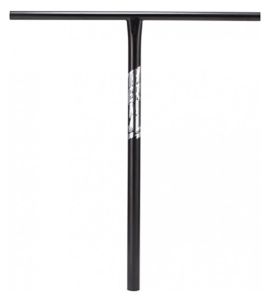Compatibilitatea pieselor
If you want to learn something, you must first of all be willing to do the now almost forgotten activity of reading.
At a basic level, the following is true: Everything fits everything, but sometimes it needs a little help. And this is true even for components from one brand.
What to look out for
1. Buying a new headset for decks with integrated vs. standard headtube
On a deck with an integrated headtube, you need to purchase an integrated threadless headset. All dimensions of the commonly available bearings are the same. The only problem may arise with the height of the top-cap. If the bearing seating in the headtube is positioned too deep, the top-cap can grind.
This can be solved:
(a) by removing the top-cap, which has primarily an aesthetic function (if you ride in a clean and dry environment, nothing will happen to the bearings).
b) using thin spacers that are inserted between the top cap and the compression ring. However, these shims are quite hard to find.
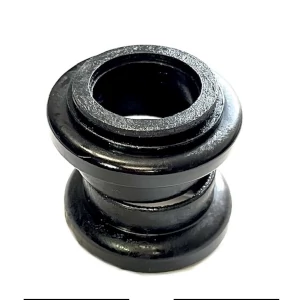
integrated headset
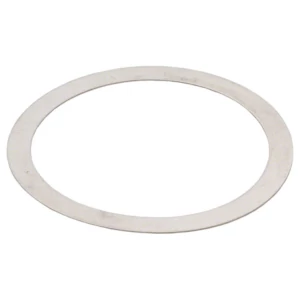
thin headset spacer
2. Buying a headset on scooters that use a threaded fork ( low-cost scooters for beginners)
You need to purchase a threaded headset (that uses ball bearings). However, nowadays this is an outdated compression system, for this reason threaded headsets have virtually disappeared from the market. You may come across them in a bike shop or bike service (threaded headsets are the same for both bikes and scooters). The price is around 100 CZK / 4 €.
There is also an alternative solution. It is possible to use a non-integrated threadless headset. In this case, you have to use the original nut, which is fitted over the new headset. See instructions on youtube:
However, this is not an economical solution. At the time of replacing the headset, your scooter will probably be worth less than the price of the cheapest threadless headset.
3. Wheel diameter vs. existing fork and deck
99% of new wheel sales are made up of wheels 110mm or larger in diameter. So most users go for larger wheels.
When switching to 110mm wheels, you need to check if your existing setup can accommodate 110mm wheels (or 115, 120 or even 125mm).
Both fork, deck and brake need to be taken into account (especially for 120 or 125 mm wheels).
Basically, a visual inspection and a bit of common sense are enough. 110 mm wheels "grow" in the fork by 5 mm in height.
Other dimensions to watch are the axle diameter and the width of the wheel. Currently 8mm and 12mm axles (8std and 12std) and wheel widths of 24, 26, 28 and 30mm are used. For more information on wheel dimensions, see .
The fundamental question you need to ask yourself is: Will the wheels fit?
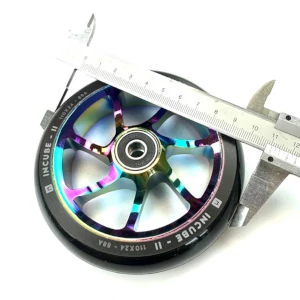
110mm 8std wheel
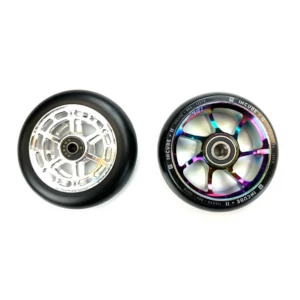
115mm 8std wheel vs 115mm 12std wheel
4. Buying a clamp vs. outer diameter of the handlebars
Handlebars have two different outer diameters: 31.8mm and 34.9mm. When making your purchase, make sure you are buying the correct diameter of the clamp for the correct diameter of handlebars.
The diameter is alway clearly specified (either in the product name or the product specification). The outer (and inner) diameter is specified for the handlebars, and the inner diameter is specified for the clamps.
Most clamps today come with a shim, which is a metal plate inside the clamp. This allows the clamps to be used for both handlebar diameters (for 31.8 mm diameter handlebars you use the shim, for 34.9 mm diameter handlebars you do not use the shim).
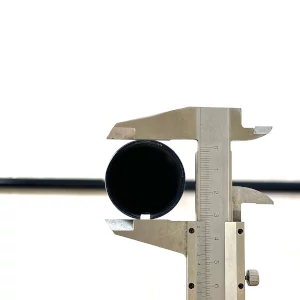
34,9 mm handlebars (outer diameter)
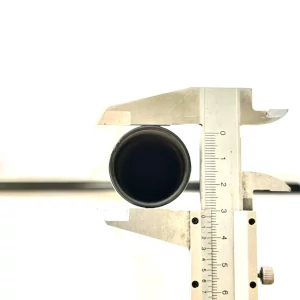
31,8 mm handlebars (outer diameter)
5. Buying a brake for a deck
Brakes are sometimes a problem. There is no such thing as a universal brake. Different manufacturers handle brakes in different ways. Nowadays, most manufacturers already offer replacement brakes on their decks, even so, you need to pay deeper attention when choosing a brake.
Therefore, it is better to call or write before buying. You can almost always find a brake that will fit your deck.
6. Buying SCS vs. existing handlebars
These lines are for those customers who are switching to SCS from another compression system.
First we need to understand what kind of handlebars we actually have. 31.8mm or 34.9mm outer diameter handlebars? Slitted or non-slitted handlebars? Aluminum, steel or titanium handlebars?
a) Most SCS available today are compatible with both handlebar diameters (SCS comes with a shim). However, this needs to be verified in the product specification.
b) If you are buying an SCS with a shim, then you will use the shim on a 31.8mm OD handlebar, but you will not use it on a 34.9mm OD handlebar.
c) Handlebars used with SCS must not have a slit!! There are two ways to get rid of the slit:
- Cut the slit with a hacksaw or angular grinder
- Insert a shim into the slitted handlebars to eliminate the slit function.
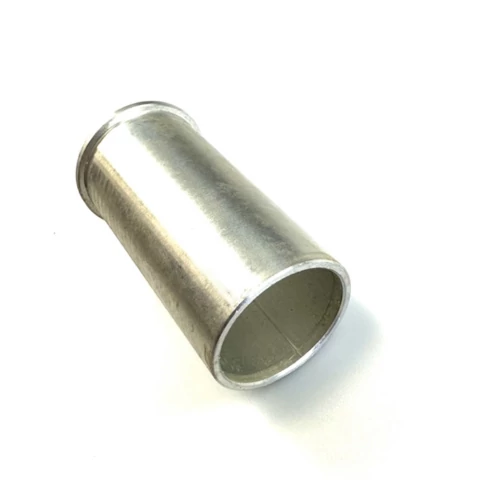
scs insert
With the second option you will not lose cca 4 cm of handlebar height. However, if you don't need the handlebars to be as high as possible, we recommend removing the slit.
What you also need to remember:
Using the SCS raises the handlebars by approx. 4 cm. If your handlebars are now 56 cm high including the slit, then removing the slit will leave you at the same height. However, if you leave the slit in place and insert a shim into the handlebar, you gain an extra 4 cm. The total height of the handlebars will then be 60 cm.
7. Purchase of HIC compression system vs. existing handlebars
CAUTION - do not confuse HIC and IHC! The systems work (and are named) similarly, but differ quite substantially in handlebar diameter and fork tube diameter. IHC is for handlebars with an inner diameter of 28.7mm, while HIC is for handlebars with an inner diameter of 31.8mm!
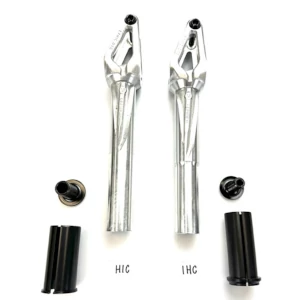
HIC fork vs. IHC fork
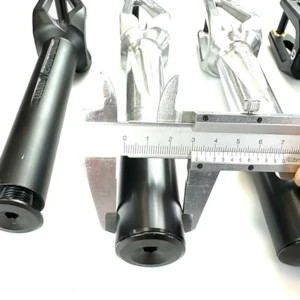
HIC shim diameter
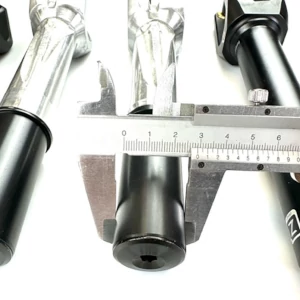
IHC shim diamete
It's simple. To use the HIC compression system, you must have CrMo / steel or titanium handlebars with an INNER diameter of 31.8 mm and no uter diameter of 34.9 mm, which also have a slit.
The HIC systém does not fit on any other handlebars.
What does the HIC system look like?
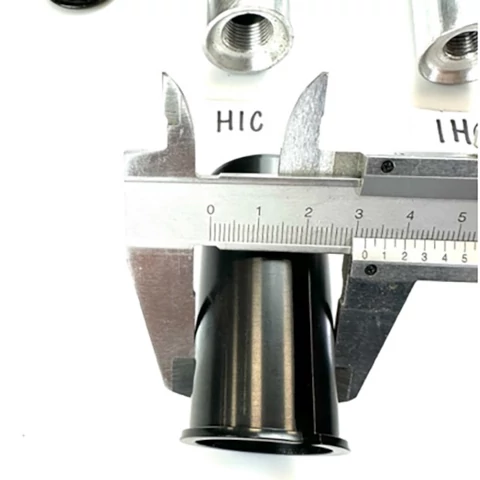
8. Buying new handlebars vs. existing compression system
Related to points 6 and 7.
What is my existing compression system? ICS, threaded fork, IHC, SCS or HIC?
If you are getting Ethic handlebars, pay attention to the length of the fork tube. Older models of Ethic handlebars have a starnut welded on the inside, and with a deck with a shorter headtube, the starnut would interfere.
What are my current handlebars (outer diameter, inner diameter, do they have a slit)?
If you are buying new handlebars for an existing compression system, it's simple. You find out what type of handlebar you have (inner diameter / slit) and buy the same type of handlebar from your preferred brand.
Note: If you want to switch to SCS or HIC compression systems, follow points 6 and 7.
9. Buying a new fork
When choosing a new fork, you need to pay attention to what compression system you are currently using. If you are using SCS, you will not be purchasing an ICS fork (although it could be modified for use with SCS, it is pointless to make life difficult for yourself).
Different deck manufacturers use different lengths (or heights) of headtube. If you have a deck with a short headtube (e.g. MGP), you may have a problem with the SCS fork (or long fork tube) being too long.
This problem can be solved by using spacers or shortening the fork tube if the SCS allows it. Headset spacers can be found on the Gizmania website here:
The normal length of a non-integrated headtube is 9 cm (10.5 cm including the headset). The normal length of an integrated headtube is 10 cm (including headset 10.5 cm). Most forks are manufactured to this dimension. For any other headtube length, you must first check the compatibility of the fork and the deck.
Related to this is the note in point 6: Decks with a short headtube cannot be combined with Ethic handlebars that have an ICS starnut welded on the inside of the tube.
10. Threaded forks and pegs
We definitely do not recommend using pegs on a scooter that is fitted with a threaded fork.
Threaded forks are made for basic entry-level scooters and therefore the fork frame is not suitable for pegs. Pegs are an additional lever that the threaded fork frame usually cannot support and can cause the fork to bend.
Plus, if someone has a scooter with a threaded fork, they are a beginner. And for beginners, pegs are more of a nuisance.





